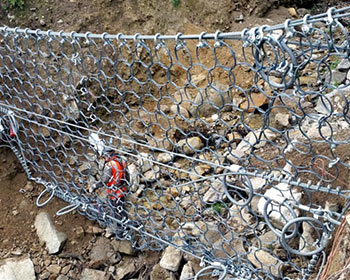Researchers Develop Models to Improve Landslide Barriers
Posted: Sep 8, 2021
 Researchers at Colorado State University developed computer models to evaluate the complex interactions between debris flows and the stress-strain response of steel structures of flexible steel, ring-net barriers, a common form of barrier used to mitigate debris flows and protect transportation infrastructure. Their work is a step toward developing more complex modeling that will assist in developing barriers that will perform effectively under various scenarios, resulting in improved protection for transportation infrastructure and enhanced safety for travelers. Debris flows—moving masses of loose solid particles, water, and air—that develop primarily on steep slopes, are an ever-present and growing risk for transportation corridors in the western United States. Because of the relative ease of construction and maintenance, flexible steel, ring-net barriers are becoming widely used to mitigate the impact of debris flows and protect transportation infrastructure. However, current design of these structures commonly does not incorporate coupled interactions between debris flow mechanics and the stress-strain response of the steel structure. Field and laboratory testing of the structures is expensive and labor intensive. Improved computer modeling of their performance should improve their design and reduce costs.
Researchers at Colorado State University developed computer models to evaluate the complex interactions between debris flows and the stress-strain response of steel structures of flexible steel, ring-net barriers, a common form of barrier used to mitigate debris flows and protect transportation infrastructure. Their work is a step toward developing more complex modeling that will assist in developing barriers that will perform effectively under various scenarios, resulting in improved protection for transportation infrastructure and enhanced safety for travelers. Debris flows—moving masses of loose solid particles, water, and air—that develop primarily on steep slopes, are an ever-present and growing risk for transportation corridors in the western United States. Because of the relative ease of construction and maintenance, flexible steel, ring-net barriers are becoming widely used to mitigate the impact of debris flows and protect transportation infrastructure. However, current design of these structures commonly does not incorporate coupled interactions between debris flow mechanics and the stress-strain response of the steel structure. Field and laboratory testing of the structures is expensive and labor intensive. Improved computer modeling of their performance should improve their design and reduce costs.
Christopher Bareither, Ph.D.
Colorado State University